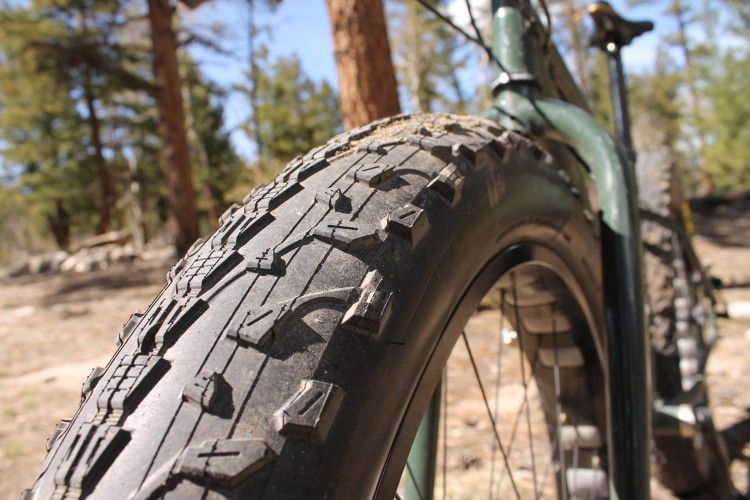
I recently had the chance to spend a full three-day weekend thrashing these Maxxis High Roller II tires on the uber rocky, extremely technical trails of Mountain Creek Bike Park. I really put them through the grinder, and here’s how they came out on the other side.
Specs
The open, trapezoidal, ramped knobs are pretty aggressive and give the High Roller II excellent soil penetration and mud clearing ability. The square profile of the knobs provides a solid, consistent feel when heading straight with no pitch. With no real transition knobs, but an offset line of shoulder knobs, there is a slight amount of squirm until you get to the side knobs. If you’re a rider who does pitch the bike, this is advantageous. However, if you are a rider who doesn’t, you may feel a bit uneasy at times. The modified knobs on the shoulder and center improve braking performance and traction on hard surfaces. One thing that the High Roller II does very well is stopping.

Inside this 26 x 2.4″ tire (61 x 559) you get a tough 60 TPI DH casing. All the downhill-specific models are wire bead, so sorry weight weenies if you were thinking these were light. At 1,260 grams, these are competitive in weight as far as DH-specific tires go, but not the 500 grams that a trail bike or XC bike would use.
I tested the single compound version–Maxx grip and 3C versions are also available. The single compound tire is the longer-lasting, but slightly-less-grippy, member of the trio.
Installation was easy on my Mavic Deemax rims, with little need for tire irons. I mounted these with Stan’s Sealant, and have been running them tubeless ( these are not UST tires and Maxxis will not cover these under warranty if a problem develops) . A bit of soap on the beads before mounting makes these snap nicely into place and they seal up quickly. I set the pressure to 28 PSI front and 30 PSI rear for Mountain Creek’s big rocks.
Out on the Trail

As mentioned above, I did test the tires out at Mountain Creek, but I also spent a while with them at Blue Mountain first. Since Blue isn’t nearly as steep as Mountain Creek, and since the runs are much smoother overall, these tires looked barely worn after my time there.
Now at Mountain Creek… that was a different story! The three days we were there they wore pretty fast on the rock, chewing up the center tread due to braking. The High Roller II’s perform best in softer conditions like medium pack to soft dirt, and work well on the rocks with little signs of slip. On the dry, sandy surface from terrain with little rain, they didn’t do as well, with a bit more squirm than I would have liked. In dry corners (with loose dirt), pitching the bike helped a bit to reduce the squirm but felt (at times) a bit inconsistent. On the rocks and roots, however, I didn’t mind the High Roller II’s at all.

There was plenty of grip on rock, evident with the amount of wear that Mountain Creek dished out on these tires. After a rain, with the terrain a bit more tacky they felt much better, allowing for more consistency with a lot less squirm. Even though there are no real transition-specific knobs, the offset cornering knobs and the alternating center knobs do a good job transitioning between upright to pitching the bike, with little squirm on medium to softer terrain (not sand). As far as rolling resistance, I can’t say these are the fastest tires out there, but they roll along quite nicely. But that is the price you pay trying to strike the balance between traction, mud shedding, and speed.
For about $76 you’re getting a decent overall tire for your gravity bike. Once you get used to the tire and learn to pitch the bike, these feel a lot better.
Bottom line: they are a decent all-around tire, but the softer, loamy turf is where these truly shine.
Many thanks to Maxxis for sending the High Roller II out for review!





















7 Comments
Aug 3, 2012
Aug 3, 2012
Aug 3, 2012
Aug 4, 2012
Aug 3, 2012
Aug 4, 2012
Aug 6, 2012